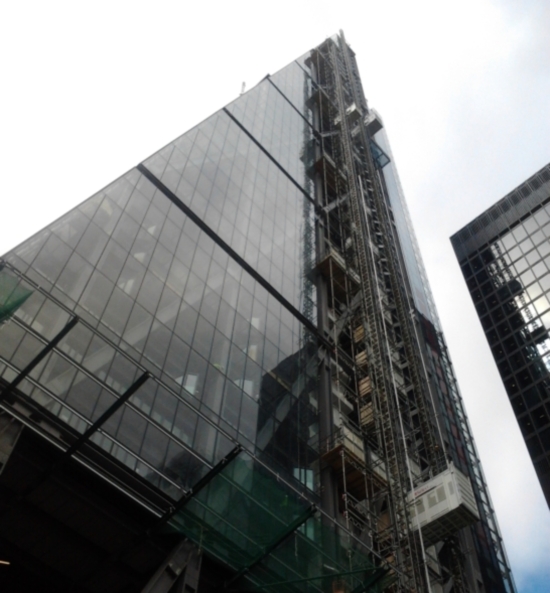2013 was the year the commercial property market began its recovery from the downturn that followed the financial crisis of 2007. It has been a year of improving news with stories of new developments and rising values regularly featuring on our pages.
However, there is still some way to go before we reach pre-recession levels and the retail sector continues to struggle as a result of changing consumer habits and prohibitively high business rates. The coming year is forecast to be an exciting one for the industry but, before it begins, let’s take a look at what has been making the news in 2013.

Construction of the Leadenhall Building was progressing well in the springtime
In January we reported that 2013 was the year during which the fall in commercial property values was expected to halt. We also featured a story about the government extending the start-up loan scheme to encourage entrepreneurship. However, it wasn’t all good news as Jessops became the first retail casualty of 2013 adding to the number of empty high street properties.
Flooding was widespread early in the year and in February we reported that acres of West Country farmland remained underwater and could take months to recover. Later in February it emerged that commercial property values had fallen for the 15th consecutive month in January. On a brighter note, we also reported that demand was increasing for West End property and that high street bookmaker William Hill was planning to open a further 100 outlets.
In March 20,000 property professionals gathered in Cannes for the annual MIPIM expo. The talk along the Croisette was that the market was on the verge of recovery after years in the doldrums. March also saw the opening of Yorkshire retail development Trinity Leeds along with news that demand for industrial property in the county had doubled.
Springtime came late in 2013 but this didn’t stop the Leadenhall Building surpassing the height of the Gherkin. By April the framework had reached the 39th floor and the glazing operation was well underway. Another London commercial development not going so well was that at Smithfield Market, which attracted objections from conservation and heritage groups.
May brought news that the Manchester office market was on course for recovery and that office construction in London had hit a four year high. There were also signs of increased market activity throughout the country. On the other hand, retail vacancy rates rose and it was forecast that one in five shops could close within five years.
The government sought to boost speculative development in June as consultation began on its plans to provide business rates relief on new-build commercial property. The results of this disappointed many in the industry who had hoped for greater incentives. In other news, UK farmland was forecast to triple in value and the Crown Estate announced record profits on its £8.1 billion portfolio.
July brought a heatwave and as the UK enjoyed the sunshine the regional office market was also heating up with reports of rising take-up coming from many areas. Elsewhere, plans were announced to raise London’s Crystal Palace from the ashes – or rather to construct a replica of the nineteenth-century building which burned down in 1936.
By late summer the market was looking in much better shape than it had at the outset of the year and in August it was reported that commercial property values had increased for the third straight month. There was also news of a slight reduction in retail vacancy rates.
The good news continued in September with the market performing well across all sectors and a slowdown in the rate of shop closures. The Walkie Talkie development in the City was also making headlines as intense sunlight reflected onto the street below damaged cars and other properties. Briefly, 20 Fenchurch Street earned another popular moniker – the Walkie Scorchie.
In October it was reported that office take-up on London’s South Bank was at its highest level since 2007. At the same time, overseas investment continued to flood in as the capital’s international popularity showed no signs of declining. Other news included reports that the newly privatised Royal Mail was sitting on very lucrative property assets.
In November UK architects reported rising workloads as confidence in both the residential and commercial sectors increased, providing a further indication of market growth. There were also a number of encouraging reports of heightened activity from The North East.
In December we have continued to bring you a wide variety of commercial property news just as we hope to in the year ahead. All that remains is to wish all our readers a very happy new year and a prosperous 2014.